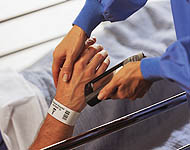How Effective are Bar Codes in Medication Administration?
 The plastic wristband that identifies patients in hospitals often carries a scannable bar code with specific medication information matching bar code information on the medication itself. Traditional wisdom suggests that this technology would make it easier and safer for nurses to administer the appropriate medications to the patient.
The plastic wristband that identifies patients in hospitals often carries a scannable bar code with specific medication information matching bar code information on the medication itself. Traditional wisdom suggests that this technology would make it easier and safer for nurses to administer the appropriate medications to the patient.
A recent study published in June 2012 in the online edition of the Journal of the American Medical Informatics Association suggests, however, that bar coded wrist bands carrying medication information matched with the appropriate medication may not be favored by nurses and, in fact, some may work around the technology to avoid the scanning process.
Although the study was small – just 83 registered nurses at a 236-bed Midwestern pediatric hospital were polled – the results suggest that administrators should determine the ease of use by nurses prior to implementing bar code technology. In this scenario, a majority of the nurses who were polled rated bar coded medication administration (BCMA) as moderately easy to use, but more than half indicated that they thought BCMA did not make patient care any easier, and nearly one third – 28 percent – said that if they had the choice they would not use it. Those nurses also said that they believed their colleagues would find ways to avoid using it as well.
A nurse who commented via blog to the 2012 study report personally observed colleagues who used the bar coded armband as a key ring, scanning the band at the medication cart versus scanning the armband on the actual patient. “Obviously,” she said, “it was not the norm, but totally de-valued the idea behind patient identification for safety purposes. We need to work on this technology.”
A similar study conducted in May of 2010, was reported in the New England Journal of Medicine. This larger study focused on the efficacy of bar code verification technology within an electronic medication-administration system (bar code eMAR) in reducing serious medication error, particularly during order transcription or administration of medication.
In this study, researchers observed 14,041 medication administrations and reviewed 3,082 order transcriptions. Non-timing errors, adverse drug reactions in non-timing errors, timing errors, and transcription errors were all reduced, although not eliminated, with the use of bar coded eMAR.
Bar codes in medication administration can, at their most basic level, help verify the “five rights” of patient care: the right patient, right drug, right dose, right route, and right time. Getting buy-in from the nurses responsible for administering the drugs using can accelerate acceptance of the technology and improve its appropriate use.
See related articles:
How the New FDA Bar Code Rule Can Impact Drug Packaging
Health Care Bar Code Scanners Improve Patient Safety
Best Practices For Bar Code Wristband Formatting
{jcomments on}
